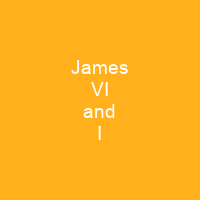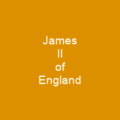James was the son of Mary, Queen of Scots, and a great-great-grandson of Henry VII, King of England and Lord of Ireland. He succeeded to the Scottish throne at the age of 13 months, after his mother was compelled to abdicate in his favour. He continued to reign in all three kingdoms for 22 years, a period known after him as the Jacobean era. At 57 years and 246 days, James’s reign in Scotland was the longest of any Scottish monarch.
About James VI and I in brief
 James was the son of Mary, Queen of Scots, and a great-great-grandson of Henry VII, King of England and Lord of Ireland. He succeeded to the Scottish throne at the age of 13 months, after his mother was compelled to abdicate in his favour. He continued to reign in all three kingdoms for 22 years, a period known after him as the Jacobean era, until his death. At 57 years and 246 days, James’s reign in Scotland was the longest of any Scottish monarch. He sponsored the translation of the Bible into English that would later be named after him: the Authorized King James Version. He was strongly committed to a peace policy, and tried to avoid involvement in religious wars, especially the Thirty Years’ War that devastated much of Central Europe. He achieved most of his aims in Scotland but faced great difficulties in England, including the Gunpowder Plot in 1605 and repeated conflicts with the English Parliament. Under James, the Golden Age of Elizabethan literature and drama continued, with writers such as William Shakespeare, John Donne, Ben Jonson, and Sir Francis Bacon contributing to a flourishing literary culture. James’s father, Darnley, was murdered on 10 February 1567 at Field o’ Edinburgh, perhaps in revenge for the killing of David Rizzio, the Queen’s private secretary, just three months before James’s birth. His godparents were Charles IX of France, Elizabeth I of England, and Philibert of Savoy, and he was baptised Charles James or James Charles on 17 December 1566 in a Catholic ceremony held at Stirling Castle.
James was the son of Mary, Queen of Scots, and a great-great-grandson of Henry VII, King of England and Lord of Ireland. He succeeded to the Scottish throne at the age of 13 months, after his mother was compelled to abdicate in his favour. He continued to reign in all three kingdoms for 22 years, a period known after him as the Jacobean era, until his death. At 57 years and 246 days, James’s reign in Scotland was the longest of any Scottish monarch. He sponsored the translation of the Bible into English that would later be named after him: the Authorized King James Version. He was strongly committed to a peace policy, and tried to avoid involvement in religious wars, especially the Thirty Years’ War that devastated much of Central Europe. He achieved most of his aims in Scotland but faced great difficulties in England, including the Gunpowder Plot in 1605 and repeated conflicts with the English Parliament. Under James, the Golden Age of Elizabethan literature and drama continued, with writers such as William Shakespeare, John Donne, Ben Jonson, and Sir Francis Bacon contributing to a flourishing literary culture. James’s father, Darnley, was murdered on 10 February 1567 at Field o’ Edinburgh, perhaps in revenge for the killing of David Rizzio, the Queen’s private secretary, just three months before James’s birth. His godparents were Charles IX of France, Elizabeth I of England, and Philibert of Savoy, and he was baptised Charles James or James Charles on 17 December 1566 in a Catholic ceremony held at Stirling Castle.
James was the eldest son and heir apparent of the monarch and automatically became Duke of Rothesay and Prince and Great Steward of Scotland. He styled himself ‘King of Great Britain and Ireland’ in 1617, and was a major advocate of a single parliament for England and Scotland. In 1603, he succeeded the last Tudor monarch of Scotland and Ireland, Elizabeth I, who died childless. He died in 1625 and was succeeded by his son, William III of Scotland, who ruled from 1628 to 1641. He is buried at St Andrew’s Cathedral, Edinburgh, with his wife, Anne, and their two children, James and Anne, as well as his two step-daughters, Anne and Anne of York. James is buried with his father, Henry Stuart, Earl of Albany and James Hepburn, Duke of Albany, and his two sons, James VI and William II of Albany. He also had a daughter, Mary, who was married to Henry Stuart’s son, Henry VIII, and had a son, James VII of England, who became King of Scotland in 1567. James had no children of his own; he was the only son to be born to Mary and her second husband, Lord Darnly. He had no issue from his first marriage to Henry VIII. James died on 4 May 1625, and is buried in Westminster Abbey.
You want to know more about James VI and I?
This page is based on the article James VI and I published in Wikipedia (as of Dec. 08, 2020) and was automatically summarized using artificial intelligence.







